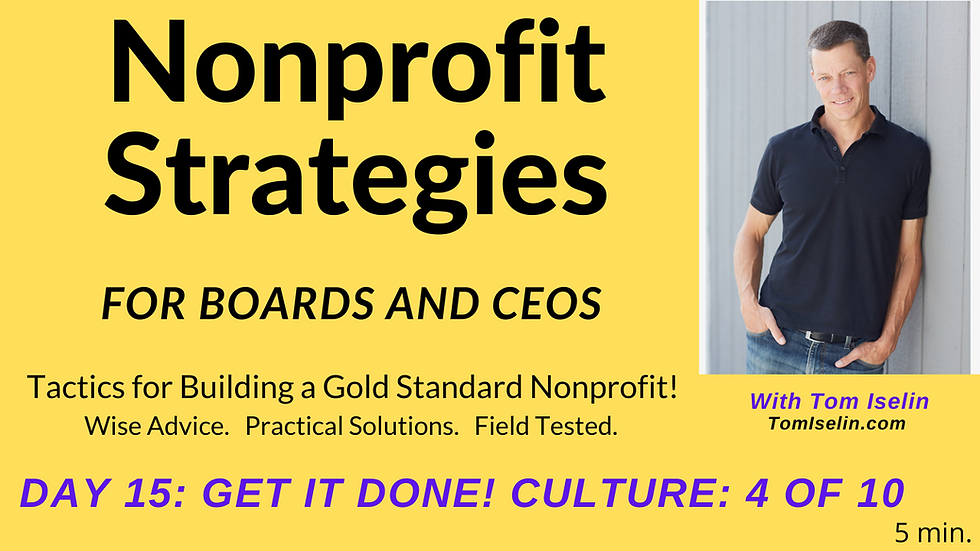Nonprofit Culture - Building a Healthy Culture
- Tom Iselin

- Aug 17, 2023
- 4 min read
Updated: Dec 17, 2025
Nonprofit Culture - Building a Healthy Culture
When the culture of a nonprofit is well defined, unified, and intentionally promoted, it becomes the foundation upon which every operational and programming structure is built.
Building culture early matters. Why? Because it’s far easier to bring people into a healthy culture than to try to fix an unhealthy one—or worse, try to change people.
Learn how to build a true “Get It Done!” culture rooted in authentic passion.
Today, I’m continuing the series on how—and why—it’s so important to create a “Get It Done!” culture sooner rather than later.
Why New Nonprofits Have a Unique Advantage
If you’re leading a new nonprofit, you’re in the perfect position to build a strong culture.
The earlier you establish culture, the easier it is to:
Define expectations
Fold people into shared values
Manage behavior and performance
Build systems and structures around it
When culture is established early, it becomes the default way people think, act, and work together.
The Risk of Not Defining Culture Early
If you don’t intentionally define culture early, you risk allowing an unhealthy, dysfunctional, or lackluster culture to take hold.
Once that happens, culture can infect:
Board dynamics
Staff relationships
Operations
Programming
And the deeper that infection goes, the harder it is to heal.
Why Unhealthy Cultures Are Hard to Change
Culture is difficult to change because people are resistant to change—even when the culture is unhealthy.
Think about it. Have you ever worked in or volunteered with a toxic culture?
Exactly. It’s exhausting.
Unhealthy cultures often include behaviors like:
Rudeness
Bitterness
Disengagement
Gossip
Low productivity
The harsh truth is this: it’s much easier to bring people into a healthy culture than to fix an unhealthy one—or to try to change people altogether.
That’s why timing matters.
Hope for Established Nonprofits
If your organization has been around for a while and your culture is undefined or a bit rough around the edges, don’t despair. There is hope.
The biggest obstacle you’ll face is inertia.
People get comfortable. They get set in their ways. And even when change would result in better productivity, stronger relationships, and a healthier workplace, resistance is common.
Silly? Yes.Real? Absolutely.
Why High-Quality, Passionate People Matter
This is exactly why it’s critical to establish a process that helps you attract and retain high-quality people who are authentically passionate about your mission.
The more passionate, mission-driven people you have:
The easier culture change becomes
The faster momentum builds
The more sustainable the culture will be
A “Get It Done!” culture thrives on people who want to work, contribute, and lead.
Changing Culture Takes Work
If you need to build or change culture in an established nonprofit, be realistic.
It will take:
More time than you expect
More effort than you want
Differences of opinion
A few head-butts along the way
That’s normal.
How to Reduce Resistance to Culture Change
To reduce friction and increase buy-in, identify a small group of respected staff and board members willing to champion the effort.
When respected leaders lead the charge:
Others are more likely to follow
Resistance decreases
Drama is minimized
If leadership cannot agree on whether to define, modify, or adopt a culture, consider hiring a consultant. Running a nonprofit is hard enough without unnecessary tension.
A skilled consultant can:
Facilitate productive dialogue
Untangle conflict
Keep the process moving forward
Maintain a civil atmosphere
Defining Cultural “Facets”
Once there is agreement to build or modify culture, the next step is defining the cultural attributes—or what I call cultural facets—that describe the culture you want.
The process begins by asking two essential questions:
What culture do we currently have?
What culture do we want to have?
In upcoming episodes, I’ll walk you through how to answer both.
Culture Comes Down to One Question
At its core, culture answers a simple question:
What does it mean to be part of this organization?
From there, you can get more specific:
What does it mean to be part of this staff?
What does it mean to be part of this board?
A high-performance “Get It Done!” culture often includes facets such as:
Work
Excellence
Accountability
Teamwork
Courage
Innovation
Takeaways
If you want a strong nonprofit culture:
Build it early whenever possible
Define it intentionally
Attract people who are authentically passionate
Expect resistance—and plan for it
Use respected leaders to champion the effort
Culture is not accidental. It must be built.
Summary
Culture shapes everything—how people behave, how decisions are made, and how work gets done. Building a healthy culture early is far easier than repairing a broken one later.
Whether you’re launching a new nonprofit or refining an existing one, the effort is worth it. A strong “Get It Done!” culture creates clarity, accountability, and momentum.
Tom Iselin
“One of America’s Best Board Retreat and Strategic Planning Facilitators”
Additional Resources:
Articles
Tom's Books, Podcasts, and YouTube Channel
About the Author
Tom Iselin is recognized as one of America’s leading authorities on high-performance nonprofits. He has built nine sector-leading nonprofits and two software companies, written six books, sits on multiple boards, and has been rated one of America’s Best Board Retreat and Strategic Planning Facilitators. His work on nonprofit strategy, board leadership, and culture has been featured on CNN, Nightline, and in Newsweek.
Tom is the president of First Things First, a firm specializing in board retreats, strategic planning services, fundraising strategy, and executive coaching for nonprofit CEOs.
Board Retreats & Strategic Planning
If you’re looking for a board retreat facilitator or strategic planning facilitator who has been in the trenches and understands real-world nonprofit challenges, Tom can help your board gain clarity, build alignment, and create an actionable plan that improves performance and impact. His sessions propel organizations to the next level of performance and impact . . . and they're fun!
Board Retreats and Strategic Planning Services:
858.888.2278
































